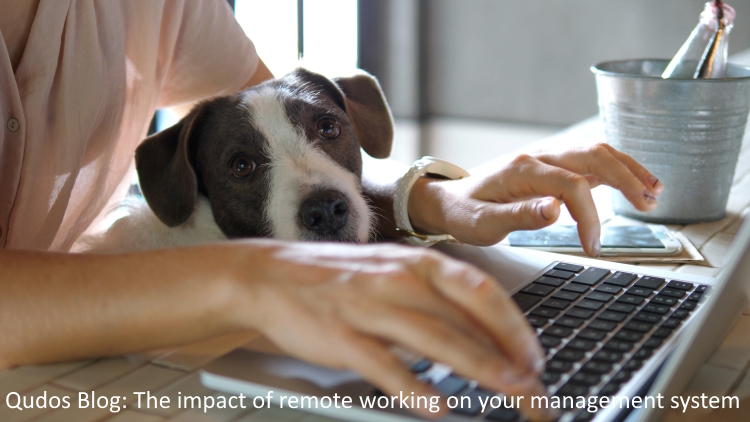What is the impact of remote working on your management system?

12 April 2023. Recent events such as the COVID-19 pandemic have created many new trends or accelerated some existing trends affecting business. A great example of that is Remote Working a.k.a. Working From Home or WFH.
While remote working is not for everyone, it has certainly struck a chord with some, and many people are wanting (or even expecting) to work from home for some or all of the time. In terms of recruitment, this is definitely a candidate-poor market in many industries, which means that to attract and retain workers, organisations are having to adapt to a new reality. They must consider how to accommodate the desire by some people to work from home, while minimising risks that poses and even taking advantage of opportunities it may offer.
The impact of remote working on management systems
It's a significant change to transition a number of people to remote working. Initially, it was addressed by many as an emergency measure for business continuity, in the longer term, It needs to be considered more carefully just like any other significant factor affecting business. There are a number of success factors to consider. For instance, we need to:
- Make those arrangements effective and efficient.
- Ensure the health and safety of the workers.
- Maintain the security of information that they access or process.
Let’s briefly look at some of those:
ISO 9001 Quality: Making effective and efficient arrangements
You must clearly communicate the anticipated deliverables. What level of productivity is anticipated? Have a plan for general team briefings, communications about the work to be performed, any checking, and other matters as necessary.
Tech Republic reports that there is some evidence that remote workers are actually more productive. A Global Workplace Analytics survey indicated that 53 percent of remote workers said they were likely to work overtime - compared to just 28 percent of in-office workers.
People need to have the necessary resources available to them. This is likely to include computer hardware and software, mobile phone and internet plan. Of course, the very nature of cloud software facilitates remote working. It can generally be quickly expanded and available anywhere with a suitable internet connection.
Reducing the size of the workforce that are in the office may potentially offer the opportunity to reduce space and accommodation costs.
ISO 27001 InfoSec: Maintaining information security controls
Protection should be in place to avoid the unauthorized access to, or disclosure of, the information stored and processed when remote working. The work will typically involve the use of one or more mobile devices. Therefore, consideration needs to be given to both the remote working scenario itself and the relevant device(s). Factors to consider include:
- The physical security of the premises.
- Registration of computers / devices.
- Separation between business and private use.
- Restrictions on software to be installed.
- AV / Malware protection.
- Access controls.
- Backup arrangements for any data stored locally.
- Remote access arrangements to internal systems.
- Family and visitor access to equipment and information.
Many organisations choose to implement an endpoint or mobile device policy and a remote working policy. Information security considerations can also be included in a self-assessment checklist.
ISO 45001 OH&S: Ensuring the health and safety of remote workers
Organisations must provide and maintain a work environment that is healthy, safe and without risks to health. That applies to your workers, or others that may be affected by their work. Such requirements still apply when someone is working from home or another remote location.
The challenge is how to ensure that when the organisations owners / managers have probably never been to the worker’s home. The answer for many organisations is a self-assessment process. Your checklist should include items such as:
- Fire safety.
- Ergonomics (e.g. suitable desk / chair / lighting).
- Emergency measures (e.g. first aid and evacuation).
- Electrical hazards etc.
Another important factor to consider is the mental health and psychological well-being of any workers that work remotely for long periods of time. Arrangements should be in place for regular contact to avoid isolation.
ISO 14001 Environment: Reducing your footprint?
It's self-evident that working from home means less commuting. From an environmental perspective, the impact of remote working is mostly a positive one. It at should mean a lower carbon footprint for anyone that would have been using private or public transport to get to work.
Resources
We have made a number of relevant resources available to our Qudos3 software subscribers. They include:
- Change Management Plan.
- Communications Plan.
- Remote Workplace Self-Assessment Checklist
- Remote Working Policy
Don't forget that as long as they have an internet connection, all your important documents can be made available to people working from home using the Qudos3 Documents module.
We regularly post on a range of topics relating to managing systems. Click the LinkedIn Follow button below to keep informed.
There's nothing like word of mouth to share creative content. So, if you found this blog useful, please share it with a colleague or business associate.
Further reading:
Working remotely: A professional's guide to the essential tools. (Article by TechRepublic).

